"This frozen planet is a the last outpost of the Trimeka system, it is known for it's hardworking people who have resisted and adapted to this harsh world. Some of the best furs in the nation come from here and so does many meat delicacies. However, it's mostly famous for it's Guardians of Vinedren, an elite force used to protect the elites of the Empire." - Senator, Maes Prim
Vinedren is a planet located in the Trimeka System, in the Lewis Galaxy and Herschel Space. It belongs to the Empire of Mankind and is known for being a frozen world, the planet of origin of the Guardians of Vinedren, one of the most excellent and better trained bodyguards of the empire.
The planet has a low degree of humidity, making the atmosphere lacking much of the usual clouds other planets have. The continents are frozen in ice or covered in packed snow that rarely melts. This white surface reflects UV light back to space which makes Vinedren even more cold than it will with clouds. However, in rare occasions, specially in winter times, clouds arise and fall in snow and in summer the snow melts (although never enough to disappeared). It flows to the oceans and the cycle can begin again.
Surprisingly enough, many species have adapted well to the planet who eat specially tuberculous and "plants" that live in snow areas. Some animals even feast for months. For this, the fauna is incredibly resistant. The economy of the planet is based for the most part on water exports, mining, fishing, military training, techology, research, energy production, contruction and manufacturing.
Geography[]
The planet has two large continents or icecaps if you prefer. This continents are Retran and Nobradis. They are separated by three masses of water, the Taldusu Ocean, the largest. The Vinisu Ocean, the shortest ocean which divides the continents and the Meuro Ocean, which covers the northern hemisphere.
- Retran
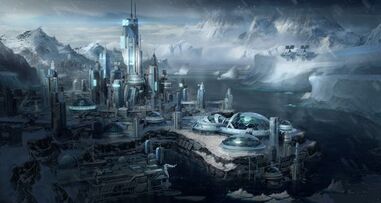
This planet is the one most filled with life. The coast is filled with bays, harbors and fiords rich in marine life. Cities have also built over the area to avoid the hard wins of the hinterland. A large mountain range called Geron Mountains, crosses the continent offering shelter to several species and even plants. The lake region is filled with lakes all over overing as well a large reserve for fauna to persist. Retran is by far the most suited for life out of the two continents. It is also the most populated.
The economy of the planet is basically water exports, mining, fishing, military training, techology, research, contruction and manufacturing. The largest city is Dilvadira, followed closely by Lurden. The total population is 4 billion.
- Nobradis
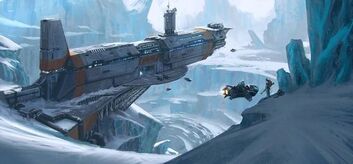
Space port on Vinedren
Not much is known other than it is a covered wasteland of ice and emptyness. The large desert of Yistru covers large parts of the hinterlands. The large mountains known as Orbersi Mountain range is located here. The mountains are a vast area of life and prosperity for the local fauna. The largest city is Arnal. The total population is around 2 Billion.
History[]
Exploration of this planet took place in 30 810 CE, but was done superficially due to the lack of interest and the priority other worlds in the system had. Another mission was sent to explore more in detail in 31 018 CE and finally in 31 134 CE a reasearch base was settled in, which had an itinerant very low population consisting mainly on scientists and military personel who did not live in the planet but came and go as they were asigned. In 31 201 CE a military base, was built as well with also a itinerant population.
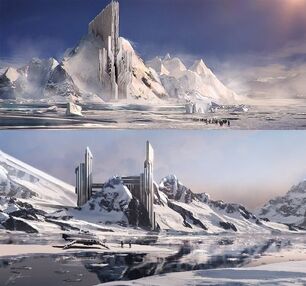
Kiruni Temple and the Seat of the Guardians of Vinedren
The planet was settled on the late stages of colonization of the system around 31 955 CE. The first permanent citizens were stablished then. For about a millennia it was the seat of several research bases and a military bases with some facilities for those who had to live in the planet. Due to it's position on the outskirts of the system, an orbital military base was also built to protect the entrance into the system. Soon, between 32 000 and 33 000 CE, mining activities arose and flourished on the planet, which saw the birth of the cities and infraestructure to what is seen today. However conditions in this world were harsh still, which kept the population low.
During most of the wars, the planet was consistenlty avoided by many of the invading forces who considered other planets of the system to be a more important target. This led to an increase in population, when many refugees scaping war in other parts of the system settled in Vinedren. This world however has been devellopping very fast in the last millennia and is achieving a high degree of growth.
Guardians of Vinedren[]
This guardians are an elite force of the Empire. This are military trained soldiers in the harsh enviromment of this planet. This is the best and most expensive commodity exported to other planets. The Guardians are not slaves but orphans usually who are trained in the ways of the militias. They have a loyalty chip implanted in them to assure their total obedience to their owners. This also forbids them from attacking or backstabing the ones they work for.
The training takes place for the first 20 years of life of the Guardian. Excersice and martial arts are tought to the apprentice. Alongside that, techniques for sigilence and refinement of the sense is also practice. A Bodyguard has to know how to detect something or someone who is potencially dangerous and thus they have to see the signs. For that, they use a drug on them that activates their senses and their premonitions on people. This beverage is secretly prepared by the trainers of Vinedren and people dont really know where it comes from. Some have questioned that the origin for this substance comes from the rings of the nearby Brelax planet.
Fauna and Flora[]
- Attalak
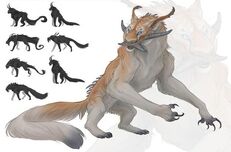
An Attalak speciment
It is the largest predator in the planet. A majestic creature of inner beauty. This animal travels vast distances and hunts all sort of animal he is able to encounter. He likes alpine and rocky areas, since the abundance of food is larger. However, they are also common to be seen hunting in the great plains or even by the coast. The Attalak is the main predator of the Lopla. They live alone and raise about 2 cups each time. Sometimes, cups up to four are seen. They mate once every 2 years and their total lifespam is for 55 years. Sometimes exceptionally reaching to 65.
- Tidrel
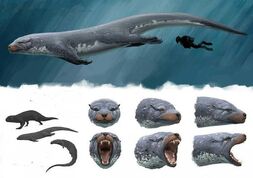
Anatomy of the Tidrel
Life on the oceans is the most common to be found on Vinedren. Large sources of fish and placton allow for large animals to exist here. This creatures lives alone and usually hunts in the oceans. It is also able to stand on the ground and usually lives near the costs and in the inner seas and straights. When not hunting they live in the bays and may even lie out of the water and hunt there. But they never go too far away from the coastline. Females usually have two or four cups. Twins are common in the species. They may life up to 55-60 years of age, although the oldest individual ever registered lived until 75 (but this is extremely rare).
- Velaron
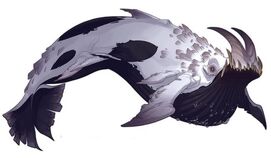
A Velaron speciment
The Velaron is a large animal, feeding on the large fisheries existing in this world. They are solitary animals and usually very fit for the cold temperatures in the planet. The Velaron has teeth which allows them to ingest great quantities of animals in a single bite. It's not aggresive when unprovoke but they tend to be very territorial animals and might fight against anything that threats their food supply.
They live about 100 years and females have a calf every 5 years since they are 20 years old ending their reproductive years at 70 (meaning that they can have about 6 to 10 calves in their lifetime, half or a third of which usually perish). Normally, calves bread when the mother is older and more experienced have higher chances of survival. Males alway live alone.
They are nomadic but that's not entirely true; adults usually travel to a location and stay there for up to an entire year defending the territory from intruders if it's a good feeding spot. Once ready, they leave the spot for another area where they repeat the process. A male has a very large territory usually with several females inside of it, each with their particular territories. During this time, the female might mate with the male and rise the calf inside the territory for it's first year. Sometimes females with calfs from other fathers live in another's males territory which usually cause no problem. Males tend to avoid hurting calfs at all. Females are known to go as far as killing a male that tries to hurt their calf.
- Nedrul
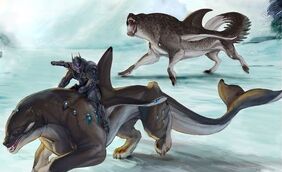
Domesticated Nedrul
This animal is a strange animal able to walk on land and also to live on the oceans and seas. They thrive mostly in the nearby areas of lakes, rivers and small seas all over the planet Never in open ocean but sometimes seen by the coastline. They survive by hunting large prey and fishes in the shallow waters. They are social animals and have a variety of diet that includes meat and fish protein. They can be seen eating shells and other crustaceans if needed but their most favourite prey is the Lopla and sometimes they may hunt Yagla as well. They live and hunt in packs of an average of 10 members.
This packs usually are led by a male and female alpha. In times of scarcity or problems, they are the only ones to mate and they only mate among themselves. Usually the cups born of them are the ones to stay in the group. However, in normal times or times of abundance, the other females reproduce as well. Each female is able to control their heat and usually reproduces by turns. In a group of 10 nedruls, 5 are females and of these usually 3 are in reproductive age. This means that the Alpha female is the first one to have cups, then the other two depending on their hierarchical position will have cups when their turn arrives. So usually a female is a mother each 3 years on average. All the group is in charge of raising and teaching the cups. This means that around summer time, the Nedrul always have cups to raise. This are usually around 4 to 5 but it's common than a third die in the first year of age: so about 2 to 3 survive each year. Then they remain with the group for at least 1 or 2 years learning the basis of hunting and survive. This teaches them valuable lessons that would be useful in the future if they leave the group. If the group is too big, which is almost always the case, the younger members are expelled and they form their own pack joining other youngsters from other packs.
The Nedrul have been successfully raised in captivity by the early settlers of the planet. They are used in multitude of tasks, most notably by the armed forces. They are appreciate by their loyalty, which is inmense towards their owners. They are less aggresive than their wild companions but might be as ruthless if needed to be. They are ride often by the settlers in case of need.
- Lushians
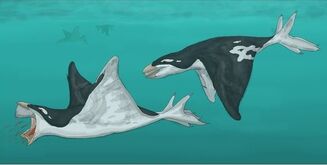
Lushians hunting
This creatures are related to the Wiglun but are more hervibore like. They eat small fishes, algae and others and are usual prey of many other predators, like the Nedrul, the Zandalax or the Tidrel. They live in large groups of 100 individuals but they dont form a hierchary or any sort of bond. They are usually just together for the protection of their numbers. They live a maximum of 15 years, but most dont ever make it to 11 years. They have their offspring all at the same time and once a year sometimes even twice a year. The females takes care of the calf until for over a year or so.
- Teshu
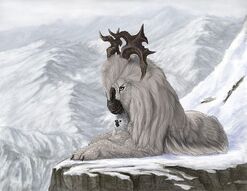
A Teshu female taking care of it's offspring
The Teshu is an animal, related to the Yagla. However, they are predators. They live in the rush lands of the interior and the mountains. It is here where they go to raise their offspring. They have horns to protect themselves and large white fur to protect them from the weather. The Teshu is very versatile and is able to eat almost anything. They are very protective of their cups and are known to be lowners who tend to avoid the company of their kind except in reproductive season. They may live up to 25 years and reproduce every 3 years or so since they reach 5 years of age, meaning that each female is able to raise about 6 cups before they die or become infertile.
However, more than two thirds usually survive as they are onminovores and are very much suited to survive cold weather and low amounts of food intake. They are as well very dedicated mothers that raise and teach their lonely cups for about 3 years.
- Zandalax
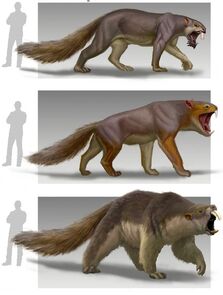
Rocky or Mountainous Zandalax (top), Coastline Zandalax (Middle) and Hairy Zandalax (Bottom).
This animal is a large predator that roams the planet. It is different depending on the habitat and region they inhabit. They are widespread all over the planet. They Hairy Zandalax, also called the White Zandalax inhabits the most difficult regions, usually the innerlands of continents. The Rocky zandalax tends to live by the mountains where the food is more abundant and conditions are less harsh. This animals however are more fearful of humans, smaller and less hairy. The Coasline Zandalax is a subspecies that lives by the coastline and the warmer lattitudes of the planet. It has an average size and mostly preys on coastal creatures and fish and rarely hunts.
The Zandalax is a solitary predator and although it mainly eats meat or fish, it is well suited to eat other things if times are harsh. Their main pray is the Lopla but they also eat other animals. They can live around 30 years and have about 5 offsprings every 3 years.
- Ogrin
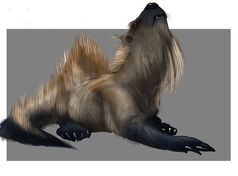
An Ogrin
The ogrin is somehow passive predator. It's an omnivore creature that hunts on anything that is able to be hunted. This means anything from plants, fish to large animals and even corpses. The ogrin is more seen in rocky regions or by the coast. They live by the regions that may melt in summer, having a change in their fur. They become yellow-blackish in summer and white like snow in winter.
This animals has one of the most powerful claws in the animal kingdom, which has allowed it to go deep into the earth and sleep for most of the winter in hybernation. They use their claws to build shelters to spend this crucial period. During the months of abundance they get out and use their claws to dig in search of food and to grasp as many fish and other animals as it can gets it's hands on.
- Wiglun
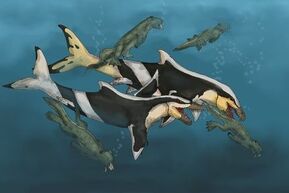
Wiglun hunting Pelabogs
Those animals are sea predators, they hunt mostly on groups and usually prey on fish and small animals. They are around 2 meters in lenght and have sharp teach and black and white colors. They are resistant and love to live in the seas not too far from the coastline. They live in groups of about 12 to 25 individuals and hunt in groups in very coordinated moves. The groups are lead by the older members. When groups become too large, the youngsters are expelled together. They then try to find other youngsters, spelled as well from their families, to form a group.
This new group will stay bound together and reproduce with for the rest of their lives. Sometimes when two groups meet, reproduction is activated so that exchange between dna of both groups is exchanged. They birth one single baby at a time but all females in a group tend to birth at the same time.
- Yagla
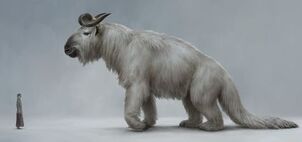
A Yagla
The Yagla is a speciment of large animal that lives mostly by the mountains or near the coastline and roams the moss that thrives in high rocky areas, thus the size of it. Some Yagla have been domesticated by the settlers of Vinedren and are used by the local farmers for work or transportation. Machinery is usually prefer but the Yagla is usually also used when machinery can get too frozen or is expensive to mantain for the farmer.
The Yagla is also raised for it's milk and fur which is exported to manufacture fine clothing and other textiles. The Yagla milk and meat are a delicacy of the local cuisine.
The Yagla have one calf every 2 years and raise it for over the same time. This means that a female gets pregnant soon after giving birth, and while they raise their offspring, they are growing the next one in their bellies. The Yagla females live in small groups of 10 to 20 members, somehow related among themselves but are quite independent. Males may spend their first 10 years of life in the group but as soon as they reach 3 meters and sexual maturity they leave the group to be on their own. The total lifespam of a Yagla is 40 to 50 years. Females reach sexual maturity at 12 years of age, and males at 10 years of age. Females however become infertile when reach 35-40.
- Lopla
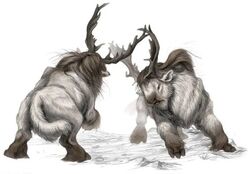
Two Lopla fighting
Its a large hervibore that leaves in the plains of Vinedren. It's a very resistant animal and can feat for very long periods. It eat tuberculous from the soil and the Harin plants, which is a set of undersnow net of intricate grass. It absorbs UV light from the reflection of the snow rather than the direct sunlight, as for the most part it is buried under it. The Lopla live in big herds of 20 to as much as 500 individuals and roam the lands of Vinedren in look of undersnow food.
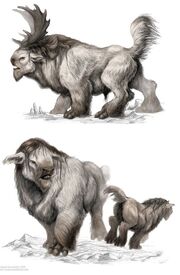
An adult male and a female with it's offspring.
They usually like to inhabit as well rocky areas, thus why they have specially design feet. The wool from this animal is highly appreciated by the local inhabitants. Many considered this species to be a stable of the Vinedrenian cuisine.
The females have one offspring every single year and take care of it for most of that year until it's big enough to join the herd. Sometimes, young males are expelled from the herd and join other groups. Young females tend to join other herds when two herds meet. This allows for the genetic pool to diversify in the species. The Lopla do not live for very long. Just for about 15 years. 20 the luckiest ones.
Large herds of Lopla have been domesticated by the settlers of Vinedren which have changed them to suit their needs. The ones in captivity produce more milk, more fur and have a more docile attitude than the ones in the wild. They also have a larger amount of meat and fat that makes this animals tastier and more nutricious to humans.
- Fakon
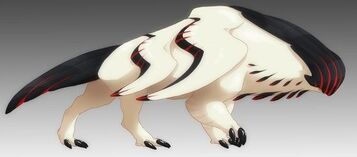
A Fakon adult
This strange creature is the only creature that is able to live on land and fly at the same time. This creature however is blind completely but has some of the best senses in the known fauna of the planet and the system even. It is able to sense heat, sound, smell and even UV and Red light much better than any other creature. It is usually good at fishing but also at roaming deep plants from the permafrost. In the mountains they are also perfecty suited to hunt and grab the creatures that may hide in the secret corners of the mountains.
The Fakon are solitary creatures that live on their own. They may reach around 50 to 55 years of age and may reach up to 4 meters in lenght. They have usually 2 calves at a time and raise them for over 10 years until they are ready to leave their parent.
- Gieglin
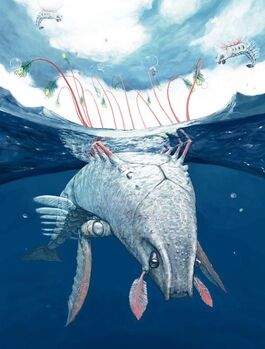
Gieglin and offspring
This weird crustacean lives in the frozen waters of the oceans. Their live in surface roaming for placton and get extra energy from the algae and sun cultivated by the large antenae on their back which need to be out of water for most of the time. It's hard crust makes it hard for most predators to prey on them. The offspring has the ability to fly and spend most of their first years flying around their mothers. They can have as many as 30 to 50 offspring on one go. However only 20-25 on average would make it back to the water and out of those, only 5 would survive to reach adulthood. When they touch water, after 1 year flying around their mothers, it's the most dangerous moment of their lives. It is risky as their crust are not fully hard and are small on size making them vulnerable to attack from predators. They will spend another year till they reach around 50 cm in lenght and their crust is hard enough to survive on their own. Then they quit their mothers and keep growing for over 5 years, in which they reach maturity. They reproduce every 5 years and live for over 40 years.
